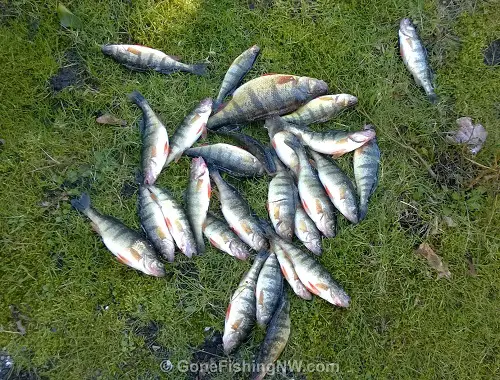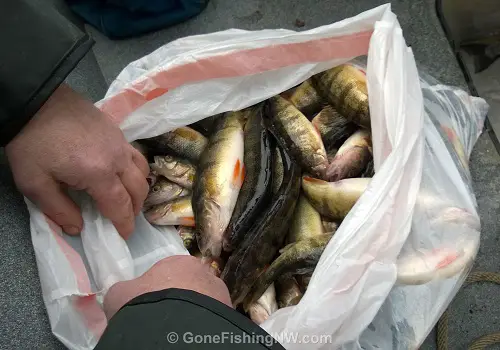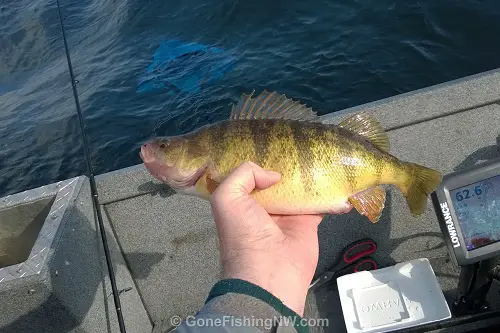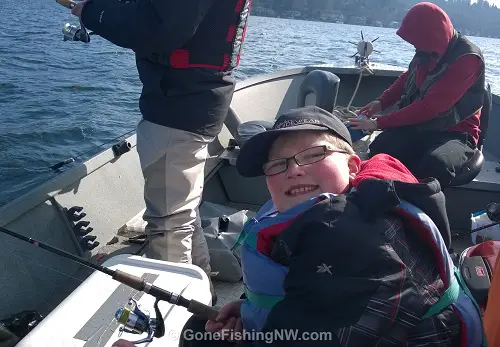Search
Latest Articles
How to Catch Perch
by Nathan Nesbit of GoneFishingNW.com, July 31, 2016
However, perch fishing can be a lot of fun, and they are quite tasty. It is a great way to get kids into fishing. In this article I'll go cover everything you need to know to go out and catch tons of perch.
This article is focused on fishing from a boat, but much of it can be adapted if fishing from shore or a dock. The vertical fishing techniques are also applicable to ice fishing.

About Perch
Perch are native to North America, but not to the Pacific Northwest. They have been introduced into our local waters - both via official and unofficial routes. You can find them in almost every lake. According to a WDFW biologist I talked to, they usually make up about 80% of the biomass in the lakes where they are present. Perch caught are usually 4 to 11 inches long, but jumbo perch do exist. In most states the record perch is between 2 to 3 pounds.
Their main predators are warm water fish species, such as bass, walleye, pike and muskie. However, mackinaw (aka lake trout) will also eat them. Trout, such as Rainbow trout and Cutthroat trout, and salmon will eat perch, but prefer other foods if they are available - so they usually aren't a major predator.
Perch spawn in the spring, in shallow waters (usually 3 - 12 feet deep), where they lay strands of eggs over weeds and structure. Water temperature is often the trigger for spawning - around 50 degrees. The preferred temperature range for perch is 63 to 77 degrees, but the optimal temperatures are 70-75 degrees. This preference plays a large part in what depth you will find them at. They tend to be in water that is 68 degrees.
They typically don't suspend much, and are commonly found in the bottom 5% of the water column. They like lake bottoms made up of muck, sand and gravel.For some reason they like to overwinter in the deep areas of the lake, rather than the shallower areas they inhabit during summer. As the water cools, they will gradually move from the shallows to the depths, and not return to shallow waters until spring.
Perch are considered poor swimmers. One study clocked perch moving at 0.46 MPH in 50 degree water. In warmer water of 68 degrees they swam faster at 0.73 MPH. Compare that to rainbow trout which have been recorded of having burst speeds over 20 MPH.
Perch are meat eaters and primarily eat zooplankton, aquatic insect and smaller fish. They are also cannibalistic and will eat another perch.
Perch are known to school together. They form schools in the morning, which then disperse at night. The schools are usually 50-200 fish, and within a school are typically the same age, size and sex.
As the fish get older and bigger, they are more likely to travel alone. Fortunately, we can still pick them up on the fish finder.
Perch in Our Northwest Waters
The perch in our northwest waters have a significant impact on trout and salmon. That impact comes in 2 ways - completion for food, and predation. Perch each the same food that trout and salmon eat in freshwater. This diet includes zooplankton, midges, leeches, crayfish and aquatic injects. Any body of water has a limited "carrying capacity" based on it's food supply. If a bunch of perch are eating all the foot, then there is less for trout and salmon smolt to have.
Once perch are around 2 years old they mostly feed on smaller fish. A study was done which found that in Lake Sammamish during the spring, when the chinook smolt do they outbound migration, that about 50% of perch had chinook smolt in their bellies. It stands to reason that this occurs in other bodies of water where salmon smolt and significant perch populations co-exist. So by fishing for - and killing - perch you are not only having fun and catching a tasty meal, but you are also helping improve the odds some poor salmon smolt will make it to the ocean. As a bonus the state general rules for perch are no limit on size or number - you can keep all you want. Although make sure to check the regs for the specific lake you are fishing, as a few have more specific rules. Let me encourage you to keep every perch you catch, even if it is small.
How To Fish For Perch
Fishing for perch is pretty easy, which is why it is so fun for kids. You can use simple techniques like bait and a bobber. Or you can get sophisticated with expensive lures.

Whichever way you choose, the key to success is finding the perch. Once you find them, you will find that the perch usually aren't very picky as to what they will hit, and the catching is usually pretty easy.
Finding Perch
Water temperature is the major factor in determining where the fish are. Knowing about the seasonal changes of a lake is key to figuring this out where they will be. In spring, once the water reaches about 50 degrees, you'll find the fish in the shallows, around 3 feet deep, close to shore. Look for structure like docks and downed trees, as well as weeds. As the water warms up to 60 degrees they will start moving out towards deeper water, about 5 feet deep. Still concentrate around structure. When the water hits 70 degrees, they will move still deeper to about 10 feet deep. This is when you'll start picking them up on the fish finder. Target the deep water side of the weed line - that is where the weeds end. Shoal areas, especially on the lee sides of points of land are good places to focus. For the rest of summer, until the water starts to cool in the fall, use an underwater thermometer to find what depth of water is 68 degrees. This will be the upper end of the thermocline. Once you determine that depth, then find water that deep. Zoom your fish finder to focus on the bottom. Slowly cruise around (about 5 MPH) until you see fish. From fall through winter, focus on increasingly deeper waters - scouting the water with your fish finder until you find them.
Perch Gear
Perch are small fish, and will be most enjoyable to catch on light gear. A 6 foot ultra light rod, with a sensitive tip works well. Match this with a small spinning reel, spooled with 4 or 6 pound mainline.
Fishing The Weeds Areas
When fishing the weeds, or around structure, the bobber and bait technique is ideal. This can keep your gear out of the weeds and snags, so you get maximum fishing. For bait nightcrawlers are a good typical bait. Maggots, salmon eggs, crickets or small bait fish are also good baits.
Setup your bobber rig
Tie your size 6 to 8 hook on the line. Position the bobber so the bait will be right above the weeds. Add a small splitshot between about 1 foot above the hook. Put bait on the hook - make sure the point of the hook is sticking out. Cast out and wait. When the bobber starts moving weird, or goes under, do a gentle hookset and fight in the fish.
Fishing The Shoals
When fishing the shoals (flat weedless areas 5 to 15 feet deep), doing some horizontal jigging is a great way to go.
To horizontally jig: Setup your jig rig. Use a jig like a Crappie Thunder or Rapala Jigging Rap,1/8 oz to 1/4oz. White and chartreuse are popular colors. Cast it out away from the boat. Let it settle down to the bottom. Give it a quick twitch, moving it about 1 foot towards you. Reel in the slack and wait for the lure to settle back to bottom. Repeat this until the lure no longer reaches bottom, then reel all the way in and recast.
The same bait and bobber technique also works, but a sliding float may be needed to get the bait deep enough. Additional weight may need to be added as well.
Fishing Deep Water
For water deeper than about 20 feet I like to either drop shot bait, or vertically jig. To vertically jig, you can use the same jigs as horizontal jigging - like a Crappie Thunder or Rapala Jigging Rap.
To vertically jig: Setup your jig rig. Select your jig and tie it to the mainline. You may need to use a slightly heavier jig to aid it going deep. Let out line until the lure hits bottom. Reel it up about 6 inches. Let it sit still for about 10 to 15 seconds, then give it a quick twitch. Repeat wait and twitch until a fish strikes. If you feel a tug, then gently set the hook.
To drop shot: Setup your drop shot rig. Tie a size 6 to 8 hook onto the mainline, leaving about 1 foot on the tag end.The palomar knot is often used. If you want the hook to point up, then run the tag end of the line through the hook eye one more time. from top to bottom. Tie a weight into the tag end - usually 1/4 to 1/2 oz. Bait the hook. Let out line until the weight hits bottom. Reel in until the weight hits bottom. Wait until you feel a tug, then gently set the hook. Give it a quick twitch once in a while to make it look alive. When drop shotting you can use the same bait as with the bobber rig. You can also use plastics. If using plastics prefer minnow shaped ones with a quivering tail. Curly tail grubs are less desirable, since they require faster movement to work correctly.
Catch the Jumbos
If you want to focus on size, rather than numbers, then jumbos are for you.

Jumbos will follow the same temperature and depth as other perch, but will be found more away from the schools. One place to look is shoal areas where the bottom is made of boulders that will allow them to hide and ambush their prey. Another good place to look is at the drop offs near the edges of schools. Transitions in bottom type are also key to finding the jumbos - weeds to clear, sand to gravel, etc. You can use the same techniques and lures as for smaller perch. But using larger baits, or lures can sometimes be the trick. This might be a good time to break out some of your favorite bass lures too.
Professional Tips
These are the things the masters do that cause them to catch more fish. Thanks to all the various people who have shared their "secrets" - in person and online.

Cannibalism Isn’t So Bad
It turns out one of the best baits for perch is other perch. The tradition in my boat is to take the first perch caught, name him "Frank" (I have no idea why), fillet it out and use it for bait. Cut strips roughly 1 inch long and 1/4 inch wide, in a pennant shape. Leave the skin attached as this will help keep the bait on the hook. Then slide it on the hook - narrow side away from the hook. This drives the perch nuts, and you will after be able to use the same piece of bait for several fish. Another trick is perch eyes - if you aren't squeamish. Remove the eyes from a perch you catch and stick them on the hook. This guy has made a neat tool to remove perch eyes.
Master the Drift
Rather than anchor up to fish, just let your boat drift. That will let you cover more water - which is very useful when targeting the solitary jumbos. If the drift is faster than about 0.5 MPH, then you need to slow it down with either your motor or drift socks. Remember perch are poor swimmers, and will not be able to catch them, if your offering is moving too fast. You may also need more weight to reach bottom due to the drift - especially in deeper water. If you aren't reaching bottom, then you aren't really fishing.
Chumming
If the regulations for the body of water allow it, then chumming can be a way to both attract in perch and keep them near the boat. In shallow water chumming can be as simple as occasionally throwing a handful of something around the boat occasionally. Things to use as chum when doing this are: For deeper water you need some kind of container to hold chumming material together. This could be a mesh bag or metal container. Usually some extra weight is needed to get it down to bottom. You want your chum to disperse, but at a more controlled rate. Materials to made your chum from includes:
- Rice
- Corn
- Oatmeal
- Canned tuna
- Cat food - especially fish based ones
- Perch Chum Basket
Drop your chum container down to the bottom and let it sit.
Perch Callers
Perch callers are simple devices you can use to make some noise underwater and stir up the muck a bit. There are commercial and DIY perch callers which consist of a metal tube, with a long bolt that runs through it. The end of the bolt has some nuts and washers that will bang against the side of the tube as it moves. It gets lowered to the bottom, and then every once in a while, someone pulls the rope up and down to cause the caller to generate some noise. An alternative I've heard about is getting 5 to 10 of the largest steel washers you can find and tie them together about 1 inch apart. I'd use a strong braid line to tie them together, and then connect that to a rope (or even the line of a spare fishing rod). Then use it as you would the pipe perch callers. This would generate a similar noise as the washers fall on top of each other. In a pinch, you can use your anchor. Pull it up and down to thump the bottom. When fishing shallow you can use your boat motor to generate noise for those curious perch to come and investigate. Just start it up and let it idle for a while. This works best when fishing water that is shallower than 15 feet.
Drop Shot Like An Expert
The drop shot rig is a very effective setup, and in the hands of an expert produces lots of fish. There are several things you can do to the basic drop shot rig to take it to the next level.
a) Use multiple hooks - most regulations let you use up to 3 hooks on a line. Take advantage of that to cover a bit more depth. I like to space my hooks 3 to 5 inches apart, depending on how tight the fish are holding to bottom. Sometimes you'll even catch more than one fish at the same time.
b) Spread out your hooks - a wire spreader bar can distribute your offering across a slightly winder area.
c) Add Attractors - a bead, spinner blade or even a bit of yarn can spice up that plain bait & hook offering, and give you more fish attraction.
d) Use a jig for weight - perch are often right on bottom, so why waste that premium spot with a lead weight? Use a jig as your weight, so it can double as one of your hooks. A tear drop jig works great for this.
e) Let hooks move - The problem with attaching your hooks with the palomar knot is that the mainline holds them tight and prevents any movement. Some alternatives are to use a dropper knot, and then attach the hook to that via a leader. Or put the hook on the line using a loop knot, like the Huckabee Loop Knot. Either of those alternatives will let the hook move around a bit, and look more alive and appetizing.
Glow in the Dark
When fishing the deeps where light doesn't penetrate as well, having a little bit of glow in the dark can make the difference in how many fish you catch. Once I was fishing deep for winter fish with a 2 hook drop shot rig. The bottom most hook was getting the majority of the fish. As an experiment I added some glow right above the top hook. Then the top hook was catching the majority of the fish. This proved to me that the perch are attracted to the glow. Adding a glow in the dark bead to your drop shot rig is one way to do it. If using jigs, then find one that comes with a little bit of glow as part of its color scheme. Don't forget to regularly "charge" the glow by exposing it to sunlight or other bright lights. I wonder what would happen if you were to put a glow stick in a chum bag, along with the chum? Hmm....
Hot Spots
It is no secret that fish tend to habitat the same spots, especially in similar conditions. Perch are no exception. Tom Pollock, one of our Seattle area fishing experts, told me a great idea that he does to keep track of his favorite perch spots. When he finds a school of perch, he marks a waypoint in his GPS. The name of the waypoint is the current date. Later when he wants to go perch fishing, he looks at his waypoints. He attempts to find a waypoint with a similar date in the area he wants to fish For example, an old waypoint labeled "5/15/2005" would match up with a current date of "5/20/2016" He then fishes those spots first. He has reported a very high success rate in finding schools this way. You could take it a step further and create a network of perch fishermen for a given body of water, and then swap hot spot data.
Processing Your Catch
Like any fish, once you've landed the fish it is best to put on ice. I usually put them in a garbage bag inside my cooler. When you are home, then the fun begins to fillet them out.
I highly suggest watching the last 5 minutes of this video to learn a great way to fillet them.
Making a Meal
There are many ways to cook up your catch. Here is a simple one to start with.
Pan fried Perch
1 cup flour
1 tsp salt
1/2 tsp black pepper
8 perch fillets
Mix the flour, salt and pepper together in a shallow bowl. In a skillet add enough vegetable oil to coat the bottom with about 1/4 inch. Heat to a medium heat. Add a fillet of perch to the mixture in the bowl, making sure to coat both sides. Place fillet in the oil. Repeat for the rest of the fillets until the skillet is full, without placing the fillets on top of each other. Cook about 2 mins on each side, until golden brown. Then remove and place on paper towels. Repeat until all fillets are cooked. Serve with tartar sauce or slide of lemon.
Nathan Nesbit
© Gone Fishing Northwest LLC
Used with Permission




